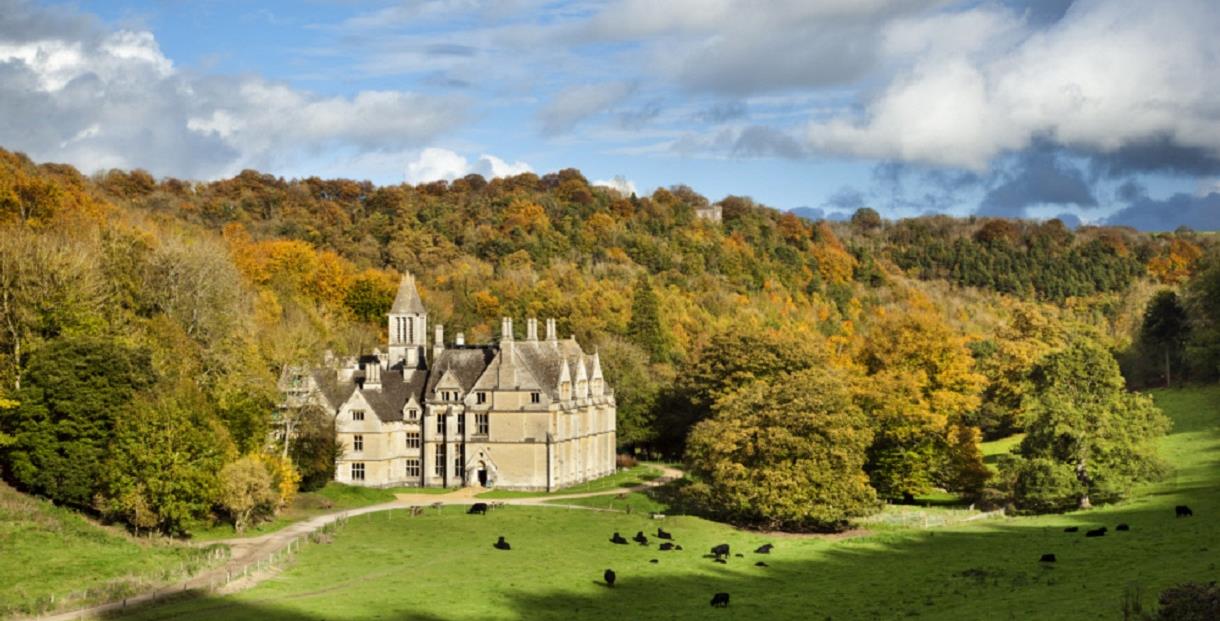To make the best of a visit here, go first to Coaley Peak for the wonderful views across the River Severn to the Forest of Dean and beyond to Wales. Then walk by crossing the B4066 and taking the minor road to Nympsfield. Enter the park via either the Mansion car park (open on certain days) or the NT car park further along the Nympsfield road. In either case, walk down to the woods and into the park. Here, there are three well-marked trails through the park. The shortest is blue (just over a mile), the next is orange (about 3.5 miles), and then the red (about 7 miles). Recommended is the orange, which will take you through woodland, around the lakes and boathouse, and past the mansion itself. Woodchester Mansion is a Grade I listed house in the Victorian Gothic style (an architectural style belonging to the later Gothic Revival of Victoria’s reign and combining French, Italian, and English elements with a free use of parti-colored materials). The architect was a local man, Benjamin Bucknall, and his patron was William Leigh, from a wealthy trading family. Both were admirers of the French architect Eugene Viollet-le-Duc (responsible for the fanciful reconstruction of Carcassonne) and there is detectable in Woodchester a significant French influence. Leigh, a perfectionist, demanded the highest standards of craftsmanship.
The Mansion is situated at the western end of Woodchester Park, in a beautiful valley, with the village of Woodchester at the eastern end. What is now the village churchyard was the site of a large Roman villa, one of many discovered in Gloucestershire, occupied between the early 2nd and late 4th centuries AD. There is now nothing visible of the villa above ground. Its most famous feature is the Orpheus mosaic, the second largest of its kind in Europe, and, depicting Orpheus charming all forms of life with his lyre, one of the most intricate. Discovered by Gloucestershire-born antiquarian Samuel Lysons in 1793, it has been uncovered seven times since 1880.
The manor of Woodchester had a series of medieval owners until in 1564 ownership of Woodchester Park was granted by the Crown to the Huntley family of Frocester, who enclosed the valley with a wall about seven miles long to create a deer park, building in about 1612 a hunting lodge at the western end of the valley. In 1631 the lodge was sold to the Ducie family, who subsequently transformed it into a Georgian house called Spring Park Mansion. The house was favored by the highest in the land, for in 1750 Frederick Prince of Wales stayed there, and in 1788 King George III visited (the same year in which he took the waters at Cheltenham, a visit that was to render that town among the most fashionable in the realm).
The Ducies landscaped the valley to form the chain of lakes and pleasure grounds that survive today. Capability Brown visited the park in 1782 but since he died the following year, it is unlikely that his plans were implemented. In 1809, however, following consultation with another eminent landscape architect, Humphrey Repton, the lakes were built by damming the stream down the valley. Further improvements and repairs were made to the park and house but by 1840 the sums of money required to sustain the estate meant that the second Earl Ducie preferred to concentrate on their other Gloucestershire estate at Tortworth and so Woodchester Park was put on the market in 1843, described as a “princely desmene” with “4000 acres of excellent land”.


0 Comments